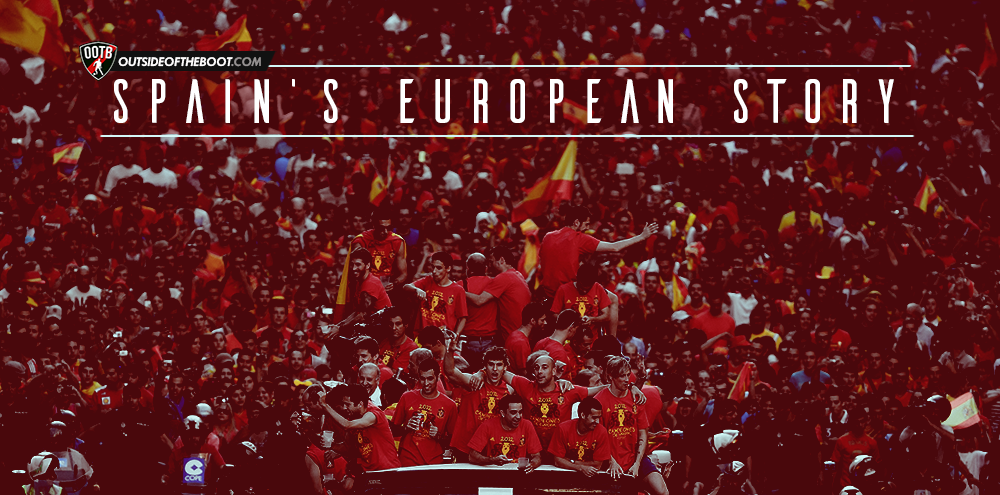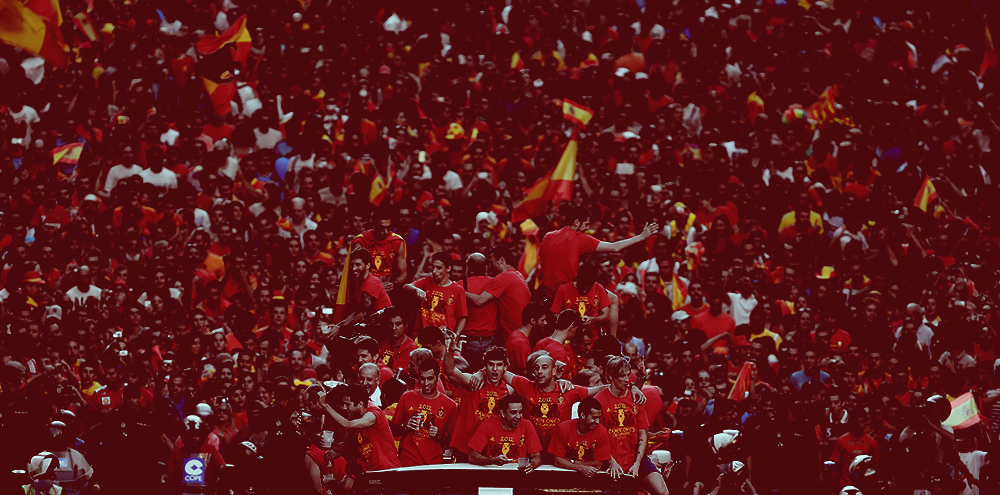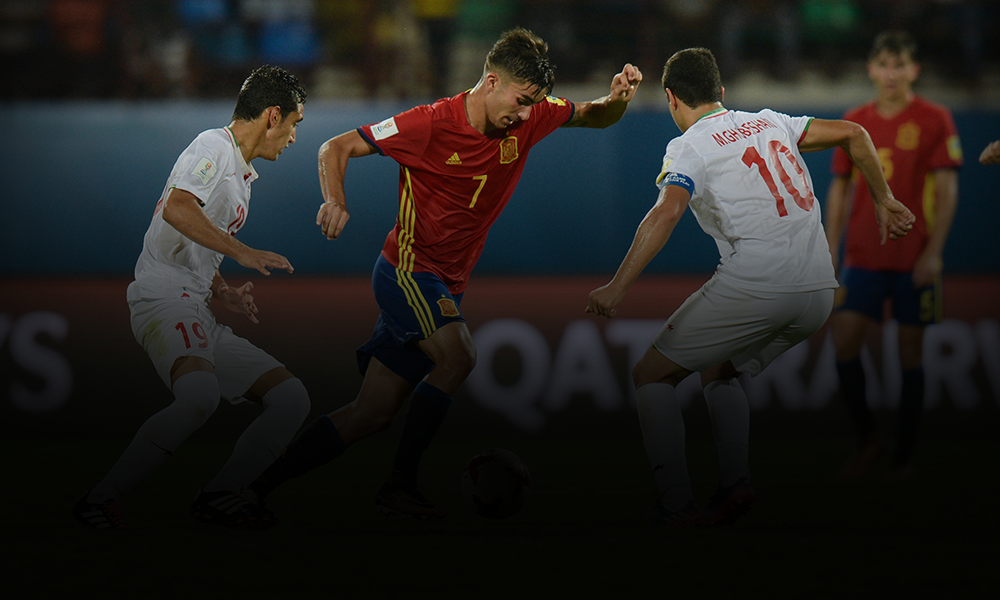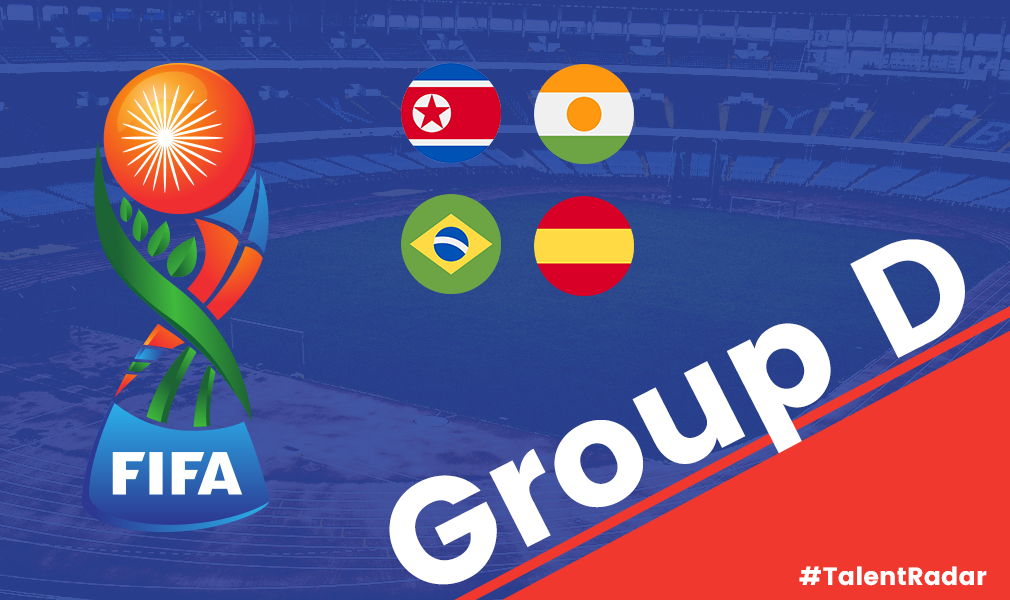
Bryan Whitelock looks at how Spain won two European Championships in a row, and tries to understand their chances of making it 3.
Introduction
Spain were always the underachievers but made a breakthrough in 2008 with their first major trophy for 44 years. This analytical piece will looks back at how Spain triumphed in 2 successive European Championships, creating history on the way, and inspiring the next generation of footballers. They created history and have dominated world football before crashing down to earth in the 2014 World Cup. 2 years on, can they get back to winning ways and make it a European hat-trick?

Euro 2008
Spain entered the 2008 European Championship with the tag of underachievers but this team, tweaked by Luis Aragones, had hopes of finally adding to their bare national trophy cabinet. 44 years earlier Spain claimed European glory and nobody was quite sure when it would happen again. By using the faultless technique of his midfield maestros, Aragones placed an emphasis on ball possession and clever movement. Spain couldn’t have started the competition much better as they demolished Russia 4-1 in the opening game with David Villa scoring a hat-trick before beating Sweden and Greece with late goals to secure top spot in the group with 3 out of 3 wins.
The quarter-finals brought a showdown with reigning world champions Italy who Spain had failed to beat in 5 attempts at national tournaments. Paired with the fact they could never seem to progress past the quarter-final stage, it was fair to say that Spain were the underdogs. A tense, cagey game meant the match would be decided on the nervous, dreaded stage of penalties. It was a matter of holding your nerve and Spain capitalised through superb stops from Iker Casillas of De Rossi and Di Natale’s penalties. The 5th and decisive penalty was left to 21 year old Cesc Fabregas who sent the keeper the wrong way and as the ball hit the net, the psychological barrier was broken, opening up the possibility of European glory.
The relief of advancing past the quarter-finals seemed to give confidence to the Spain team as they convincingly rolled past Russia again, much like they did in the group stage, but this victory was much more convincing as it was the semi-final. It was still a 3 goal margin but this 3-0 win, with all goals coming in the second half, moved Spain one step closer to glory where Germany awaited. The only downside of this exceptional result was the injury of top scorer David Villa but with Fernando Torres waiting in the wings, nothing was going to stop Spain triumphing.
16 teams started the competition and 2 remained but only one could become European Champion. Spain dominated throughout with their midfield magic leaving Germany with little answers. In actual fact, no team could deal with Spain’s midfield dominance as Xavi, Iniesta, Silva and Fabregas weaved the ball around the lush carpet whilst Senna, Spain’s midfield bodyguard, sat deep to ensure nothing got past, allowing the freedom of Spain’s midfield to rotate and attack the space.
This freedom afforded to Xavi can be seen in the image below as he occupied space between the lines of midfield and defence to open up the avenues to supply a killer pass. The role of Marcos Senna can also be seen as he sits deep in midfield supplying passes forward for the more creative players to do damage.

The decisive goal stemmed from that move in which Xavi found himself in space and with his vision and passing ability coupled with the deadly finishing of Torres, there was only going to be one outcome and Spain led 1-0.

Once Spain were in front it was always going to be an uphill task for Germany and Spain kept churning out chances whilst Germany only managed 1 shot on target in the whole game. It was no surprise as Spain had not conceded a goal in the knockout phase, keeping 3 clean sheets in a row. The final whistle finally sounded and Spain had lifted the burden to finally win a major competition and they did it in style: the Spanish way.
Following his sublime performances, Xavi, a true pioneer of the possession based game, was named the player of the tournament and David Villa, the deadly Spanish finisher, was awarded the Golden Boot for his tally of 4 goals.
Spain’s dominance led to 6 Spanish players being included in the Team of the Tournament: Casillas, Puyol, Marchena, Senna, Xavi and Villa
Spain’s 23 man squad for Euro 2008 was not the most experienced squad but it was full of talent with a lot of young players. These young players like Silva, Fabregas and Cazorla were given a chance and they certainly took it. The combined appearances of the squad was just 769 which was an average of 33 appearances per person from this blend of experience and youth. The experienced gathered from this tournament would no doubt stand all the players in good stead for future tournaments, no matter what age or previous experience.
Euro 2008 Squad
| Position | Player | Age | Caps | Club |
|---|---|---|---|---|
| GK | Iker Casillas | 27 | 75 | Real Madrid |
| GK | Pepe Reina | 25 | 9 | Liverpool |
| GK | Andres Palop | 34 | 0 | Sevilla |
| DEF | Raul Albiol | 22 | 2 | Valencia |
| DEF | Fernando Navarro | 25 | 0 | Real Mallorca |
| DEF | Carlos Marchena | 28 | 26 | Valencia |
| DEF | Carles Puyol | 30 | 58 | Barcelona |
| DEF | Joan Capdevilla | 30 | 14 | Villarreal |
| DEF | Sergio Ramos | 22 | 31 | Real Madrid |
| DEF | Alvaro Arbeloa | 25 | 1 | Liverpool |
| DEF | Juanito | 31 | 20 | Real Betis |
| MID | Andres Iniesta | 24 | 22 | Barcelona |
| MID | Xavi Hernandez | 28 | 55 | Barcelona |
| MID | Cesc Fabregas | 21 | 23 | Arsenal |
| MID | Santi Cazorla | 23 | 0 | Villarreal |
| MID | Xabi Alonso | 26 | 40 | Liverpool |
| MID | Marcos Senna | 31 | 7 | Villarreal |
| MID | David Silva | 22 | 11 | Valencia |
| MID | Ruben de la Red | 23 | 0 | Getafe |
| FWD | David Villa | 26 | 30 | Valencia |
| FWD | Fernando Torres | 24 | 46 | Liverpool |
| FWD | Sergio Garcia | 24 | 0 | Real Zaragoza |
| FWD | Dani Güiza | 27 | 2 | Real Mallorca |
Euro 2012
Spain entered Euro 2012 as world champions following their World Cup triumph in South Africa. They were aiming for a historic treble to become the first team to successfully defend their European crown and they were favourites to do so. 4 years on from their 2008 triumph and things were different. Players had retired, as had their manager, Luis Aragones, who left on a high following their Euro 2008 win, and Spain had to adapt slightly. Instrumental members of the team like Villa, Puyol and Senna were no longer competing for Spain following their retirement but the quality in the depth of players available to Del Bosque meant this was not so much an issue. Del Bosque led the team to world glory and he was aiming to become the first manager to win the World Cup and European Championships as national team manager.
In their opening game, Spain struggled against a compact Italian team and went a goal behind through magisterial work from the ever-present, almost anti-aging Andrea Pirlo who slipped in Di Natale who put the Italians one up. Spain hit back just minutes later through neat passing, as we have come accustomed to seeing in the red of Spain, as Silva played in Fabregas to level the scores. Fabregas had been causing quite an impact off the field but not through his own doing. It was his positioning throughout the tournament which caused wide debate for discussion as he was deployed in a false 9 role, similar to Lionel Messi’s at Barcelona. Following the 1-1 draw with Italy using the curious false 9, Del Bosque went with a more conventional approach as Torres started the next two games. Torres scored 2 goals against the Republic of Ireland and justified his selection as Spain took control of their group. Top spot was secured after a 1-0 win against Croatia in a tight affair, settled by an 88th minute winner by Jesus Navas following great work from Fabregas, who came on as a substitute, and Iniesta in the build-up.
Top spot in the group stage meant France were next up for this Spain side who switched back to the false 9 with Fabregas deployed again as the false 9 with close support from Silva and Iniesta as they roamed freely in between the lines of midfield and defence. The opening goal came from an unlikely source in the form of midfield anchor-man Xabi Alonso who was making his 100th cap for Spain and he was certainly doing it with great effect. The goal stemmed from the naturally attacking Jordi Alba who attacked the space behind the French defence as Iniesta fed the ball through before shaping a ball to the back post for an unmarked Alonso to simply head home.

The attacking positions of the full backs were a constant outlet and pulled the French defence from side to side as they tried to sit back and contain Spain. In the image below it is clear that Arbeloa is in acres of space as the French team is so close together to limit the space and limit the option for incisive passes through the midfield. The image also shows the freedom of the Spain midfield, also shown previously with the opening goal, as Iniesta, at least on paper, was starting on the left but finds himself very central in this particular attack, spreading the play out wide. This freedom can be afforded due to full backs occupying wide areas of the pitch. The rotation of the midfield is very clear as Silva is occupying the false 9 position with Fabregas dropping slightly deeper in search for the ball. This attacking approach from the full backs can be utilised due to having 2 holding midfielders in Busquets and Alonso who cover space and stop any opposition attacks from advancing.

The victory, and a semi-final place, was sealed in the dying minutes as Pedro was tripped inside the area for a penalty which was slotted away by Alonso to cap a perfect century appearance for him.
The semi-final against Portugal led to a major surprise as Alvaro Negredo was given a start in the place of Cesc Fabregas as Spain switched tactics yet again to go with a more recognised striker. It was a cagey match with no real chances being made and the inevitability of penalties was confirmed after scores were level at 0-0 after 120 minutes of action. Spain seemed to have the know-how of how to win these types of games and it was reminiscent of their quarter-final encounter against Italy 4 years earlier. Alonso missed the first penalty for Spain but Portugal could not take advantage as Moutinho’s penalty was brilliantly saved by Iker Casillas, who kept the scores even. The next 5 penalties were scored including a Panenka from Sergio Ramos which really showed the confidence of this Spain team and their confidence no doubt grew after seeing Bruno Alves’ penalty strike the bar and it was match point with Fabregas walking down the field to send Spain their 3rd major final in a row. Fabregas stepped up and struck the ball against the inside of the post with the keeper narrowly beaten, arrowing the ball across goal and into the net to leave Portugal bitterly close to victory and Cristiano Ronaldo left helpless, and penalty-less, on the half way line.
The opponents in the final were Italy and Spain were at another major final with the chance to create history by retaining their European crown which would further establish their dominance in national football. Spain yet again deployed their false 9 system as they had done against Italy in the group stages and they started brightly in confident mood. Spain were ahead after just 14 minutes after some incisive football led to David Silva heading in the opening goal. The image shows the move in which the goal stemmed from with Fabregas taking up a position on the right wing and running in behind the Italian defence with Silva occupying the false 9 position in a common rotation pattern which caused many problems for all defences throughout the competition.

The false 9 is illustrated perfectly in the image below as nobody is close to the Italian defenders and they have nobody to mark. Instead, Spain try to get bodies in between the lines of midfield and defence to orchestrate attacks through quick play and constant movement from the close proximity between the players. The full backs also play a role as they are high up the pitch and stay wide which creates the opportunity for Silva and Iniesta to drift inside and occupy more threatening central positions which was the case in the opening goal.

The second goal came from Jordi Alba and his intent on getting forward and breaking the defensive line of Italy. His blistering pace led him to a 1v1 with Buffon after a sublime inch-perfect pass from Xavi which he confidently put away to give Spain a two-goal lead entering half time. The image below shows Alba’s intent on getting forward which is also helped by the amount of space left through the lack of a striker by playing Fabregas as a false 9, who is on the far left of the field in this attack to show the rotation and freedom the players have.

Italy created half chances but most of them were shots from distance which Casillas easily saved but the main chance was when Di Natale found himself 1v1 on the edge of the 6 yard box from a clever reverse pass but Casillas showed why they call him Saint Iker as he sprung quickly off his line to narrow the angle and keep Spain’s lead at 2.
Spain then added another goal in the 82nd minute which was a mirror of Torres’ goal 4 years earlier as he found himself in between full back and centre back to attack the space ahead as he ran ahead onto a Xavi pass to put the game to bed and seal a historic victory.
With Italy wounded and resigned to a loss, Mata added a 4th in the 88th minute as Torres squared the ball to him to finish the game and end Italy’s misery. This succession of major trophies, a treble of the highest calibre, without question put Spain at the top of the pedestal as the darlings of world football, the envy of every nation, and maybe the best football team to ever grace the game. Their history and style are secure in football forever.
Spain’s squad for Euro 2012 was very experienced with combined caps of 1199, averaging 52 per person, a staggering statistic. This experience in caps coupled with the experience of winning major tournaments helped Spain gain the advantage in pivotal moments throughout the competition like the perfect game management in the quarter final and their bottle in the semi-final penalty shootout. 13 of the 23 players were from the previous squad (marked by *) which helps greatly as it is a settled squad who know each other’s games perfectly despite the rising tension between Barcelona and Real Madrid players due to Mourinho’s constant Barcelona complaints and encouragement to not talk with the enemy. 6 of the 7 midfielders from the previous squad started when using the false 9 which almost left nations powerless as Spain dominated the ball from this midfield dominance. Although they started with no natural wingers they did not need to as the rotation led to players picking up different positions constantly and the attacking full backs occupying wide areas at every possible opportunity.
Five Spanish players were named in the team of the tournament with Iniesta being named the player of the tournament: Casillas, Ramos, Alba, Xaviand Iniesta.
“In many ways, he symbolised the tournament – the creative, incisive runner, with and without the ball”
Andy Roxburgh, UEFA Technical Director, on Andrés Iniesta
Euro 2012 Squad
| Position | Player | Age | Caps | Club |
|---|---|---|---|---|
| GK | Iker Casillas* | 31 | 137 | Real Madrid |
| GK | Pepe Reina* | 29 | 25 | Liverpool |
| GK | Victor Valdes | 30 | 8 | Barcelona |
| DEF | Raul Albiol* | 26 | 34 | Real Madrid |
| DEF | Gerard Pique | 25 | 45 | Barcelona |
| DEF | Juanfran | 27 | 1 | Atletico Madrid |
| DEF | Sergio Ramos* | 26 | 92 | Real Madrid |
| DEF | Alvaro Arbeloa* | 29 | 41 | Real Madrid |
| DEF | Jordi Alba | 23 | 11 | Valencia |
| MID | Javi Martinez | 23 | 8 | Athletic Bilbao |
| MID | Jesus Navas | 26 | 20 | Sevilla |
| MID | Andres Iniesta* | 28 | 71 | Barcelona |
| MID | Xavi Hernandez* | 32 | 115 | Barcelona |
| MID | Cesc Fabregas* | 25 | 69 | Barcelona |
| MID | Santi Cazorla | 27 | 45 | Malaga |
| MID | Xabi Alonso* | 30 | 102 | Real Madrid |
| MID | Juan Mata | 24 | 19 | Chelsea |
| MID | David Silva* | 26 | 64 | Manchester City |
| MID | Sergio Busquets* | 23 | 45 | Barcelona |
| FWD | Pedro Rodriguez | 24 | 18 | Barcelona |
| FWD | Alvaro Negredo | 26 | 12 | Sevilla |
| FWD | Fernando Llorente | 27 | 20 | Athletic Bilbao |
| FWD | Fernando Torres* | 28 | 98 | Chelsea |
Euro 2016
Spain enter Euro 2016 on the back of a disastrous World Cup which slightly tarnished their reputation as the world’s best. People with short memories were quick to criticise but it is has no doubt been a moment of transition and a passing of the baton to the next crop of talented youngsters. The younger and less experienced players are more than capable than taking on the role of Spain’s new maestros, even if it is a big burden to fill the shoes of Alonso and Xavi who were once so vital to this Spain team. An ageing Iker Casillas and Andres Iniesta look set to make their final bow in their successful European expedition but replacements are more than at the ready from the conveyor belt of midfielders that is produced at a mesmerising rate and arguably the best goalkeeper in the world sat waiting in the wings, David De Gea.
The squad assembled by Del Bosque, who could also be making his final bow, looks like an emphasis has been placed on form, fitness and youth, no matter the experience. If they have proved it throughout the season, they’re in the squad. Aduriz, despite his grand age of 35, has been exceptional for Athletic this season and rightly merits his place in the squad where he has beaten off competition from Diego Costa, the rambunctious Chelsea front man, Fernando Torres, who looks somewhat back to his best, and Paco Alcacer, a young fox-in-the-box who should be in Spain squads for years to come. Costa has arguably been left out over his fitness or his argumentative, rugby-like, boxing style of play in which football seems to come second after fighting and causing a stir. Torres maybe performed too late in the season and Del Bosque might feels it’s time to move on from the players who done it in the past, an idea that brought arguably Spain’s downfall in the 2014 World Cup.
The new generation of players with little experience, at least on the international stage, come mainly in midfield to add new energy, ideas and fresh legs with an appetite to work impress and win their first major international silverware. Thiago, despite being a standout for a number of years at Barcelona and Bayern, has never really been given a chance with Spain due to the irremovable figures of Xavi and Alonso but with them no longer around, he can lead this Spanish midfield for years to come. Likewise with Koke whose talents have also been on show for many years. The future of Spain’s midfield looks in good hands. It is not just the younger guns of the squad who are being trusted but also the internationally inexperienced older stars of La Liga who have shone all season like Bruno, San Jose and Nolito who have also be rewarded for their impressive season and favoured over the likes of Cazorla, Javi Martinez and Mata as a shock to many.
The lesser experienced squad is proved by the combined 978 caps at an average of 38 caps per person, notably lower than combined caps of 1199 from the 2012 squad which averaged 52 per person.
The previously mentioned midfield is still one of the best, if not the best, in international football but the lack of natural wingers in the squad is easy to see with only Pedro, Nolito and Vazquez in the squad which could see them play a back-up role in the team with the option to come off the bench and change the game with their directness and fresh legs to trouble opposing full backs. The versatility of the attacking midfielders, like Silva, Iniesta and Koke, could mean that, like in 2012, they start out in wider positions and naturally drift inside.
Another lack of numbers is in the strikers department with only Morata and Aduriz being selected, opening up the possibility of the potential use of the false 9 which proved a great success in 2012. With 2 strikers inexperienced at international level, a more reliable and experienced Cesc Fabregas could take the mantle as the most attacking player on the field.
10 players have stayed in the squad since the last European Championships (marked by *) and it would seem likely that most of them would be starting when Spain line-up for their first game in France against the Czech Republic. Spain’s other opponents are Turkey and Croatia which Spain will be hoping they can negotiate past to advance to the knockout phase. 2 players were omitted from the squad to narrow it down to 23 players and Carvajal was replaced by Bellerin due to the Real Madrid man suffering an injury, ruling him out of the tournament. Isco and Saul were the 2 players omitted due to the wealth of experience in Spain’s midfield but their time will come in future tournaments.
Euro 2016 Squad
| Position | Player | Age | Caps | Club |
|---|---|---|---|---|
| GK | Iker Casillas* | 35 | 167 | Porto |
| GK | David De Gea | 25 | 8 | Manchester United |
| GK | Sergio Rico | 22 | 1 | Sevilla |
| DEF | Hector Bellerin | 21 | 2 | Arsenal |
| DEF | Gerard Pique* | 29 | 76 | Barcelona |
| DEF | Juanfran* | 31 | 17 | Atletico Madrid |
| DEF | Sergio Ramos* | 30 | 131 | Real Madrid |
| DEF | Marc Bartra | 25 | 10 | Borussia Dortmund |
| DEF | Jordi Alba* | 27 | 42 | Barcelona |
| DEF | César Azpilicueta | 26 | 15 | Chelsea |
| DEF | Mikel San Jose | 27 | 6 | Athletic Bilbao |
| MID | Andres Iniesta* | 32 | 107 | Barcelona |
| MID | Bruno Soriano | 32 | 7 | Villarreal |
| MID | Cesc Fabregas* | 29 | 104 | Chelsea |
| MID | Thiago Alcantara | 25 | 7 | Bayern Munich |
| MID | Koke | 24 | 22 | Atletico Madrid |
| MID | Sergio Busquets* | 27 | 83 | Barcelona |
| MID | David Silva* | 30 | 97 | Manchester City |
| FWD | Artiz Aduriz | 35 | 4 | Athletic Bilbao |
| FWD | Pedro Rodriguez* | 28 | 57 | Chelsea |
| FWD | Alvaro Morata | 23 | 8 | Juventus |
| FWD | Nolito | 29 | 7 | Celta Vigo |
| FWD | Lucas Vazquez | 24 | 0 | Real Madrid |
Conclusion
On the night of July 10th, this Spanish team will want to be lifting the European trophy aloft with history rewritten forever and a new era of Spain football at the envy of European hearts. Just as easily, their reputations could be further damaged after the World Cup but if they could manage to pull off a historic European hat-trick, it may well be the greatest victory of them all.
Written by Bryan Whitelock
- Guardiola and Stones: A Perfect Marriage - August 30, 2016
- Analysis: Spain’s European Story - June 7, 2016
- Analysis: The Mauricio Pochettino Effect - May 26, 2016
























































